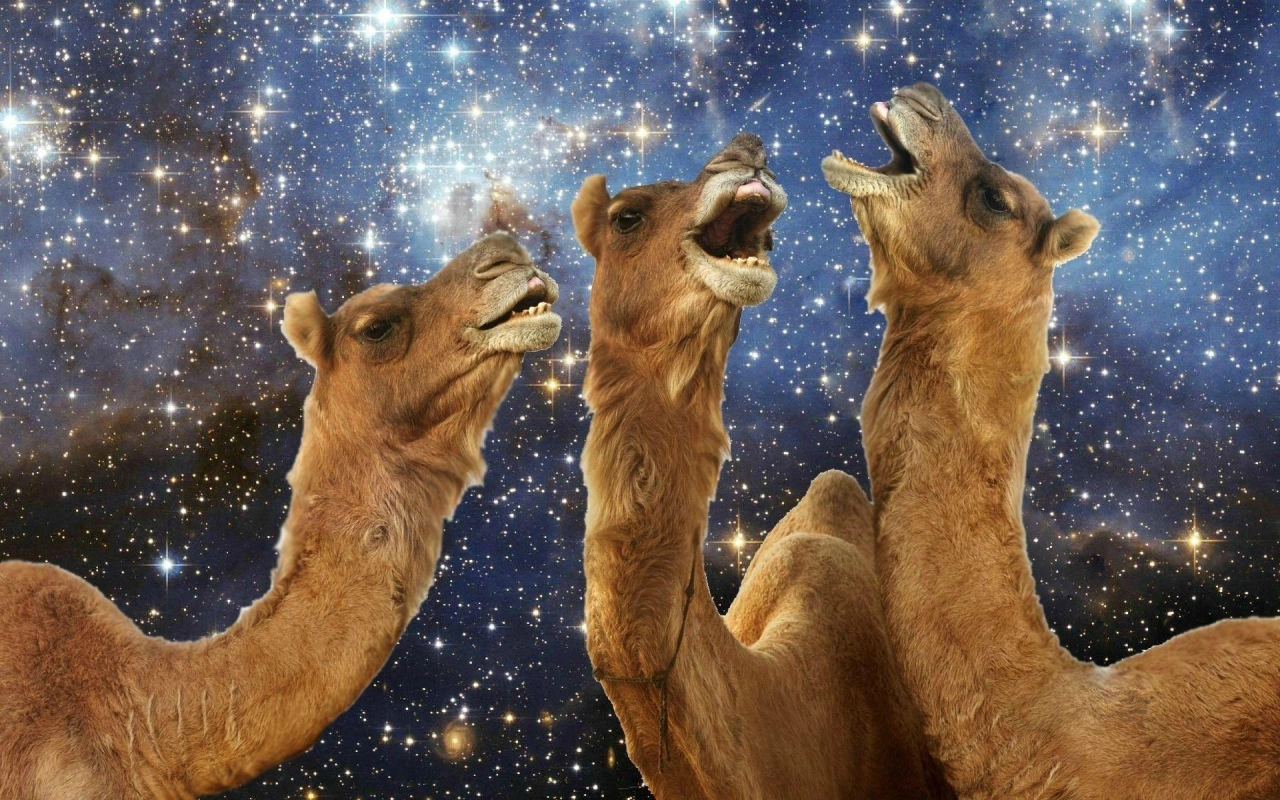The Virginia opossum, scientifically known as Didelphis virginiana, is a marsupial that is native to North America. It is the only marsupial species found in the United States and Canada.
The Virginia opossum is known for its unique physical features, including a long, hairless prehensile tail, a pointed snout, and hairless ears. It has a dense fur coat that can range in color from gray to brown, with a white face and throat.
Virginia opossums are primarily nocturnal, meaning they are most active during the night. They are omnivorous, feeding on a wide variety of foods such as fruits, insects, small animals, carrion, and even garbage. They have a flexible diet that allows them to adapt to different environments and food availability.
| Characteristic | Virginia Opossum |
|---|---|
| Scientific Name | Didelphimorphia |
| Family | Didelphidae |
| Type | Mammal |
| Order | Didelphimorphia |
| Temperament | Docile and non-aggressive |
| Lifespan | 1-2 years (in the wild), some species up to 4 years or more |
| Size | Varies by species, typically 10 to 40 inches (25 to 100 cm) in length (excluding tail) |
| Weight | Varies by species, typically 4 ounces to 14 pounds (100 g to 6.4 kg) |
| Diet | Opportunistic omnivores, feeding on fruits, insects, carrion, small mammals, birds, eggs, and plants |
| Distribution | Found in the Americas, including North, Central, and South America |
| Habitat | Various habitats, including forests, woodlands, grasslands, and urban areas |
| Other names | None widely recognized |
Physical Characteristics of the The Virginia Opossum
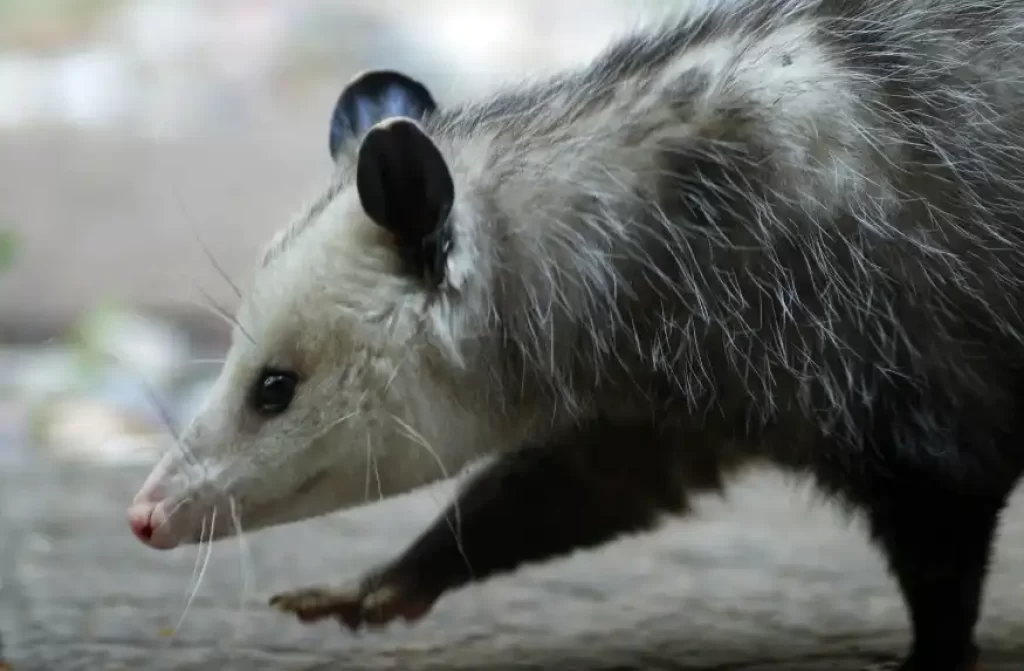
The Virginia opossum possesses a range of distinct physical features. It has a slender body covered in dense fur, which can vary in color from gray to brown. One notable feature is its long, hairless prehensile tail, which acts as an extra limb, aiding in climbing and grasping objects. Their snout is pointed, and their ears are hairless.
Body Size and Shape
The Virginia opossum has a medium-sized body, typically ranging from 13 to 37 inches (33 to 94 cm) in length from head to tail. They have a relatively stout build with a body shape resembling that of a small dog. The males are generally larger than females.
Fur Coat and Coloration
Their fur is dense and consists of two types of hair: long guard hairs and shorter underfur. The color of their fur can vary, ranging from gray to brown, with individuals displaying a mix of lighter and darker shades. This coloration helps them blend into their surrounding environment.
Head and Facial Features
Virginia opossums have a narrow and elongated head, featuring a pointed snout. Their eyes are small and black, positioned on the sides of their head.
They have excellent night vision, allowing them to navigate effectively in low-light conditions. Their ears are hairless and relatively large, aiding in sound detection.
Tail
One of the most remarkable physical characteristics of the Virginia opossum is its long, hairless prehensile tail. This tail is highly flexible and muscular, allowing the opossum to grasp and coil it around branches for stability and balance while climbing trees. The tail acts as a fifth limb, aiding in arboreal locomotion.
Limbs and Paws
Virginia opossums have five digits on their front and hind limbs. The front paws have opposable thumbs, enabling them to grasp and manipulate objects, making them skilled climbers. The hind feet possess sharp claws that assist in digging for food and climbing.
Dentition
Their dental formula is I 5/4, C 1/1, P 3/3, M 4/4, giving them a total of 50 teeth. Virginia opossums have sharp, pointed teeth adapted for their omnivorous diet. Their incisors and canines are well-developed for biting and tearing while their premolars and molars are suited for grinding food.
Reproductive Features
Females have a unique reproductive structure—a pouch, or marsupium—located on their belly. After giving birth, the tiny, undeveloped joeys crawl into the pouch and attach themselves to the mother’s teats. The pouch provides a nurturing and protective environment for the young, allowing them to continue their development until they are ready to venture out.
These physical characteristics collectively contribute to the Virginia opossum’s adaptability and survival in a range of environments.
From their dense fur coat and prehensile tail to their specialized dentition and reproductive adaptations, each aspect of their physicality plays a role in their unique ecological niche.
What is the typical habitat of the Virginia opossum?
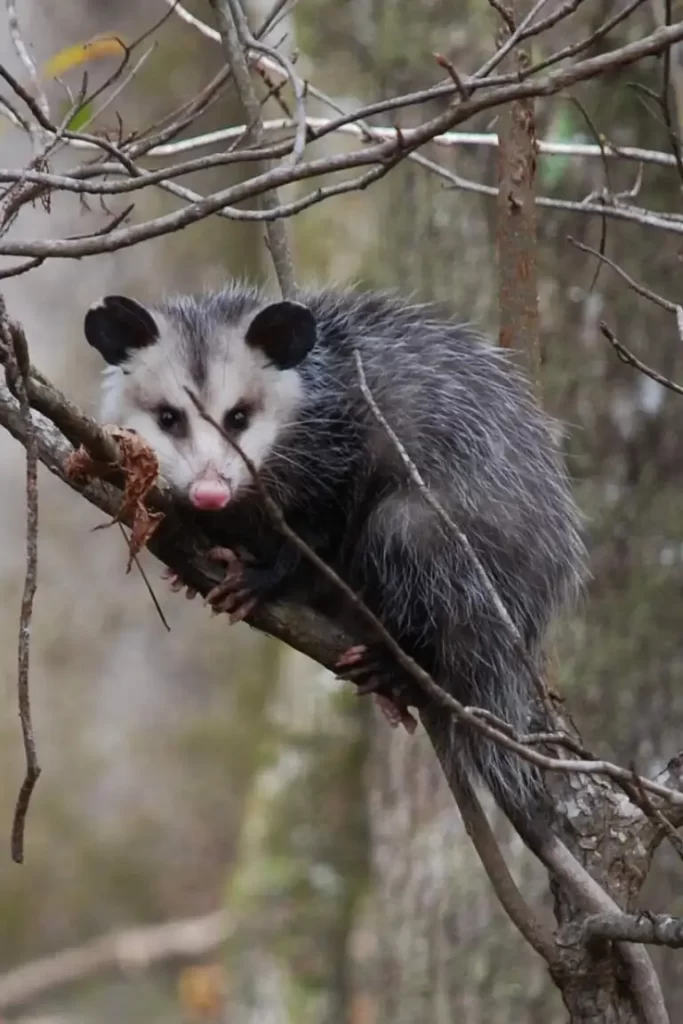
The Virginia opossum, also known as Didelphis virginiana, is a highly adaptable marsupial that can be found in a wide range of habitats across North America. Let’s explore some of the typical habitats where the Virginia opossum thrives:
Forests and Woodlands
Virginia opossums are often found in deciduous forests and woodlands, including both temperate and tropical regions.
These habitats provide a diverse array of food sources, such as fruits, nuts, and small animals, that the opossums can forage on the forest floor.
Swamps and Wetlands
They are also well-suited to wetland environments, including swamps, marshes, and riparian areas. These habitats offer a rich supply of water and an abundance of aquatic and semi-aquatic prey, such as frogs, fish, and aquatic invertebrates.
Grasslands and Agricultural Areas
Virginia opossums have successfully adapted to grassland habitats, including prairies and agricultural fields. Here, they can find ample food resources, including insects, small mammals, and carrion, as well as areas for nesting and shelter.
Urban and Suburban Areas
Opossums have shown remarkable adaptability to human-modified environments. They can be found in urban and suburban areas, including parks, gardens, and residential neighborhoods. They utilize the abundant food sources, such as garbage and pet food, available in these settings.
Coastal Areas
In coastal regions, Virginia opossums can be found in coastal scrublands, dunes, and estuarine habitats. These areas provide a mix of vegetation and access to both terrestrial and aquatic food sources.
Riparian Zones
Riparian zones, which are areas along rivers, streams, and water bodies, are also favored habitats for Virginia opossums. These areas offer a combination of dense vegetation, water resources, and diverse prey, making them suitable for foraging and denning.
The Virginia opossum’s adaptability allows it to inhabit a wide range of habitats, and its presence can vary depending on factors such as food availability, water sources, and shelter options. Their ability to thrive in diverse environments contributes to their wide distribution across North America.
Nocturnal and Omnivorous
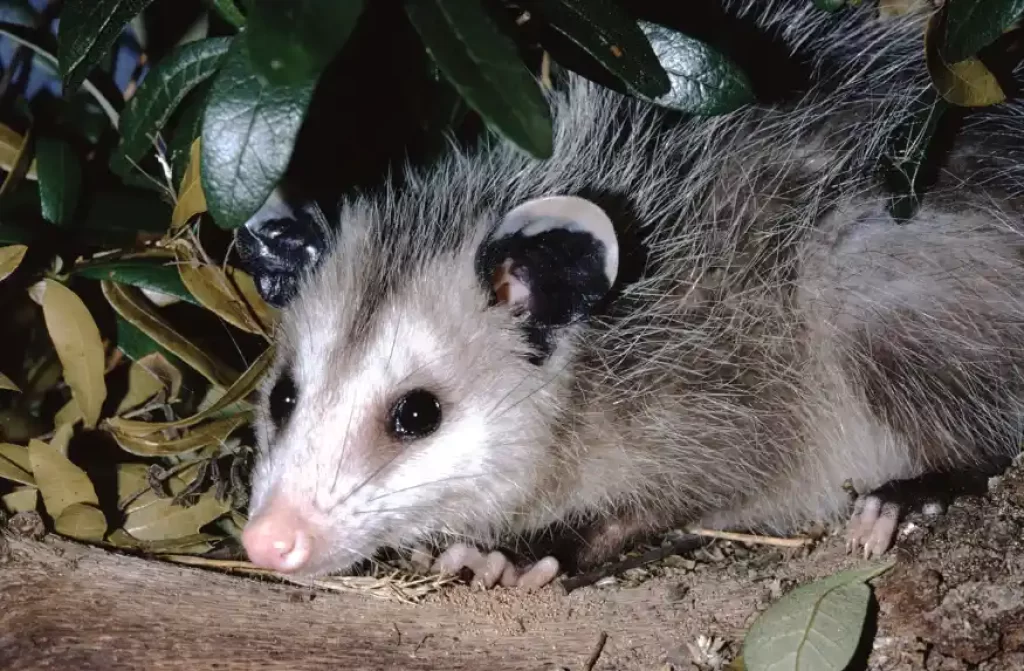
Virginia opossums are primarily nocturnal, meaning they are most active during the night. This lifestyle helps them avoid competition with diurnal animals. As omnivores, they have a versatile diet. They feed on a wide variety of foods, including fruits, insects, small animals, carrion, and even garbage. This adaptability allows them to survive in diverse environments.
Virginia opossum’s Reproductive Strategy
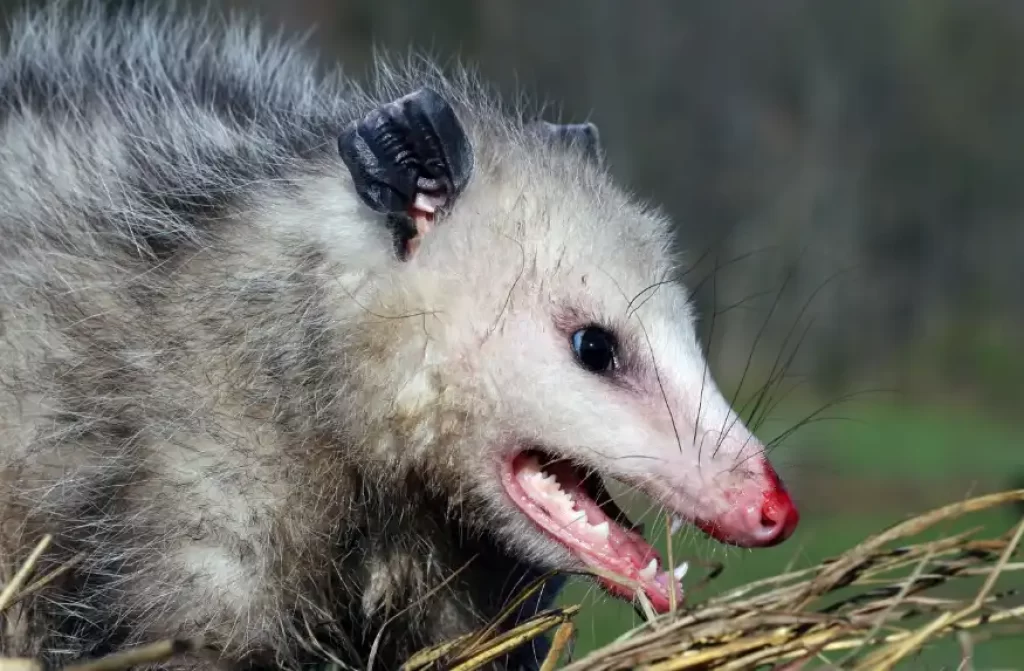
The Virginia opossum, like other marsupials, has a unique reproductive strategy that involves the use of a pouch to nurture and protect their young. Let’s explore the reproductive characteristics of the Virginia opossum:
Breeding Season
The Virginia opossum’s breeding season, which spans from January to July, is a time of heightened activity and courtship among these marsupials. During this period, males actively seek out receptive females, engaging in displays and vocalizations to attract mates.
Sexual Dimorphism
One striking aspect of the Virginia opossum’s reproductive strategy is the sexual dimorphism observed in these creatures. Males, generally larger and more robust than females, possess unique anatomical features such as a bifurcated, or forked, penis, which aids in successful mating.
Promiscuous Mating System
Virginia opossums have a promiscuous mating system, where both males and females mate with multiple partners. This behavior increases the genetic diversity within the population.
Reproductive Cycle
After mating, the female opossum undergoes a process called delayed implantation. The fertilized eggs do not immediately implant in the uterus. Instead, they enter a state of arrested development known as diapause, which can last around 11 to 13 days.
Gestation and Birth
Following the period of delayed implantation, the fertilized eggs implant in the uterus, and gestation begins. The gestation period for Virginia opossums is relatively short, lasting approximately 12 to 14 days. This is one of the shortest gestation periods among mammals.
Birth and Development
Once the gestation period is complete, the tiny, underdeveloped young, known as joeys, are born. They are blind, hairless, and about the size of a bumblebee. Immediately after birth, the joeys crawl into the mother’s pouch, where they attach themselves to one of her teats.
Pouch Development
Inside the pouch, the joeys continue their development, receiving nourishment from the mother’s milk. The pouch provides a protected and nurturing environment for the young as they grow and develop.
Weaning and Independence
The joeys remain in the pouch for approximately two to three months, gradually transitioning to spend more time outside the pouch.
Around three to four months of age, they start venturing out on their own but continue to return to the mother’s pouch for warmth and protection. Weaning typically occurs around three to four months of age.
Sexual Maturity
Virginia opossums reach sexual maturity relatively early, usually between six and twelve months of age. However, the age of sexual maturity can vary depending on factors such as food availability and environmental conditions.
The reproductive strategy of the Virginia opossum, with its unique pouch and early birth of underdeveloped young, allows for increased survival rates and flexibility in adapting to varying environmental conditions.
It is an intriguing example of marsupial reproduction and adds to the diversity of reproductive strategies found in the animal kingdom.
How do Virginia opossums communicate with each other?
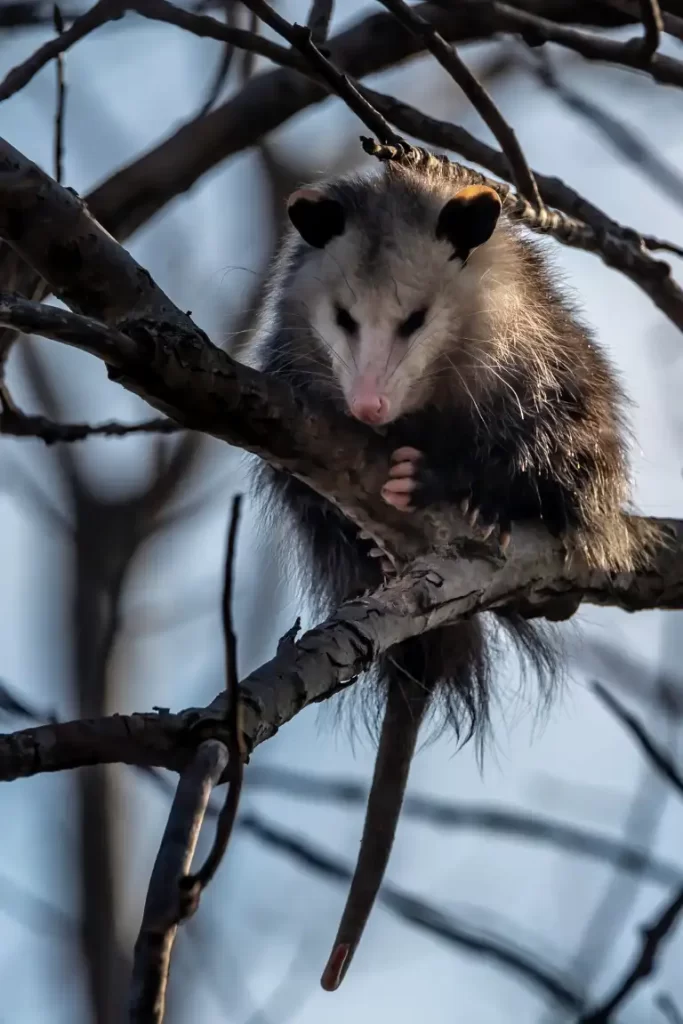
Virginia opossums communicate with each other using a variety of vocalizations, body postures, and scent markings.
While they are generally solitary animals, communication plays a crucial role in their social interactions and reproductive behaviors. Let’s explore some of the ways Virginia opossums communicate:
Vocalizations: Expressing Emotions Through Sound
Virginia opossums have a repertoire of vocalizations that serve as a means of communication. Hissing, a common defensive warning, alerts potential threats to keep their distance.
Growling and screeching sounds may indicate aggression or fear, signaling the need for caution. Chattering sounds are employed during confrontations or mating encounters, creating a unique acoustic language in the opossum community.
Body Language: Conveying Messages through Postures and Movements
In the absence of vocalizations, Virginia opossums rely on body language to communicate their intentions and emotions. When feeling threatened, they may assume defensive postures, such as baring their teeth or raising their fur, to warn potential adversaries.
Standing on their hind legs is another display used to appear larger and more intimidating. Conversely, rolling onto their backs and playing dead is a submissive behavior aimed at deterring aggression.
Scent Marking: Leaving Their Signature in the Environment
Scent plays a significant role in the communication repertoire of Virginia opossums. They possess scent glands near their anus, which they use to mark their territory and convey information to other opossums.
By leaving scent marks on objects in their surroundings, such as trees, rocks, or vegetation, they establish ownership and assert dominance. These unique odor signatures serve as olfactory messages to other individuals in the area.
Visual Signals: The Silent Language of Gestures and Expressions
While predominantly nocturnal, Virginia opossums also employ visual signals to communicate non-verbally. Through body postures, facial expressions, and tail movements, they convey messages to conspecifics.
Erect ears indicate heightened alertness, while relaxed ears suggest a sense of ease. By observing these visual cues, opossums can assess the mood and intentions of their counterparts.
Chemical Signals: Unseen Messages in the Air
The remarkable sense of smell possessed by Virginia opossums allows them to detect and interpret chemical signals in their environment.
Through scent marking and detection of pheromones, they communicate vital information.
Pheromones, chemical substances emitted by individuals, play a key role in reproductive behaviors and social interactions, enabling opossums to convey messages related to mating readiness, territorial boundaries, and social hierarchy.
Ecological Role
These marsupials play an important ecological role in their habitats. They help control pest populations by consuming insects and small animals, and they also act as scavengers, helping to recycle nutrients through their diet of carrion. Furthermore, their presence in urban areas can contribute to reducing waste by consuming garbage.
How do Virginia opossums defend themselves from threats?
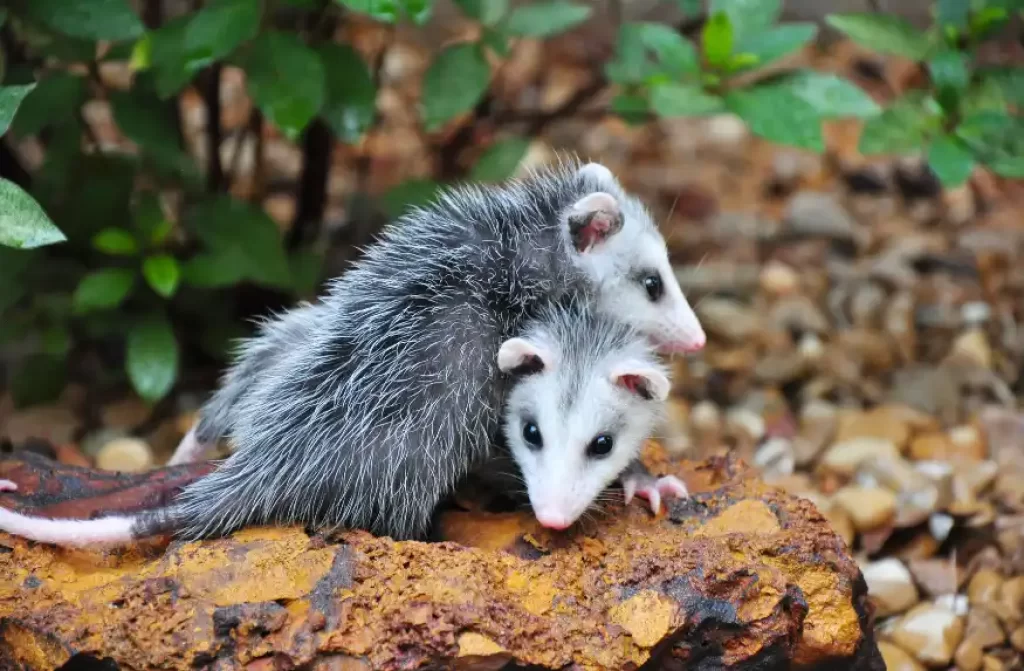
Virginia opossums have developed a range of defense mechanisms to protect themselves from threats in their environment. Despite their relatively small size and seemingly docile nature, they have evolved effective strategies to survive and deter potential predators. Let’s delve into the various defense mechanisms employed by Virginia opossums, exploring each in detail:
Playing Dead (Playing Possum)
One of the most well-known defense tactics of the Virginia opossum is its unique ability to “play dead.” When faced with a perceived threat, they enter a state of tonic immobility, where they simulate death.
This behavior involves lying on their side or back, limbs limp, eyes closed, and tongue protruding. By remaining motionless and seemingly lifeless, they deceive predators into believing they are no longer a viable prey target.
This clever act often discourages predators, as many prefer live prey and lose interest when they encounter a seemingly deceased opossum.
Vocalizations
Virginia opossums communicate their displeasure or intent to predators through vocalizations. When threatened, they may emit a series of hisses, growls, or clicks.
Hissing serves as a warning signal, communicating aggression and a readiness to defend themselves.
Growling is another vocalization used to intimidate predators and deter them from approaching further. Clicking sounds may be produced when opossums feel threatened or cornered, indicating their readiness to defend themselves if necessary.
Defensive Postures and Displays
Virginia opossums have several physical adaptations that help them appear more intimidating to potential threats. When confronted, they may arch their back, raise their fur, and puff up their bodies to appear larger.
This defensive posture aims to make them seem more formidable and less vulnerable to predators. Additionally, they may bare their teeth, exposing their sharp incisors, as a visual display of aggression and warning.
Clawing and Biting
If cornered or physically engaged by a predator, Virginia opossums can employ their sharp claws and teeth as weapons. With their dexterous paws, they can scratch or swipe at an attacker, inflicting painful wounds.
Their teeth, though not particularly large, can deliver a strong bite if necessary. While they generally prefer to flee rather than fight, their ability to defend themselves physically adds another layer of protection.
Climbing and Escaping
Virginia opossums are skilled climbers and adept at escaping predators by retreating to higher ground. They possess sharp claws and prehensile tails that assist in climbing trees or other structures.
Their nimble climbing abilities allow them to quickly ascend to safety, where many predators find it challenging to follow. By seeking refuge in elevated locations, they minimize the risk of direct confrontation.
Nocturnal Behavior
Being primarily nocturnal animals, Virginia opossums have evolved to minimize encounters with diurnal predators. By conducting most of their activities at night, they reduce their exposure to potential threats.
Their nocturnal behavior aligns with the hunting patterns of their natural predators, providing them with an added layer of protection.
Can Virginia opossums swim?
Yes, Virginia opossums are capable swimmers. While they are primarily terrestrial animals, they are well adapted to maneuvering in aquatic environments when necessary.
Their ability to swim allows them to cross bodies of water, such as streams, ponds, and marshes, in search of food, shelter, or to escape potential threats.
When swimming, Virginia opossums use a combination of paddling motions with their front and hind limbs.
Their partially webbed feet provide some assistance in propelling them through the water. Their long, slender bodies and muscular tails aid in maintaining balance and stability while swimming.
However, Virginia opossums are not highly specialized swimmers like some other aquatic mammals. They typically swim when it is required and tend to avoid prolonged periods in the water if possible.
Their swimming abilities are more geared towards short distances and crossing water obstacles rather than swimming as a primary mode of locomotion.
Do Virginia opossums have any predators?
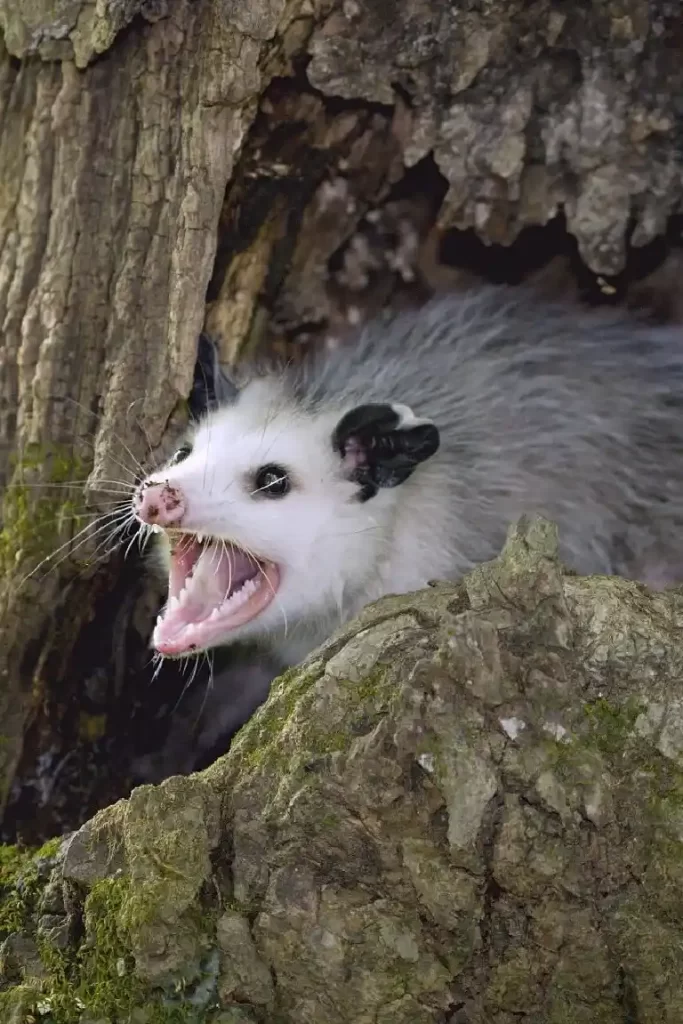
Yes, Virginia opossums have several natural predators in their habitats. Despite their unique defense mechanisms, they are still vulnerable to predation. Some of the common predators of Virginia opossums include:
Birds of Prey
Virginia opossums are not immune to the watchful eyes and swift strikes of aerial predators. Learn about the raptors that pose a threat, including owls, hawks, and eagles. Discover how their hunting techniques and preferences may impact opossum populations.
Carnivorous Mammals
The terrestrial domain holds numerous carnivorous mammals that can view opossums as potential prey. Delve into the behaviors and hunting strategies of coyotes, foxes, bobcats, and even domestic dogs that may come into contact with opossums in various habitats.
Snakes
Slithering predators also pose a danger to Virginia opossums. Explore the potential threats posed by large constrictors and venomous snakes, their hunting techniques, and the risks they present to opossum survival.
Canids and Felids
Both wild and domestic canids and felids can have opossums on their menu. Uncover the predatory behavior of wolves, cougars, and domestic cats, and how their interactions with opossums can shape population dynamics.
Human Impact
While humans are not natural predators, their activities can inadvertently impact opossum populations. Learn about the consequences of habitat destruction, the risks opossums face on roads, and the potential for hunting and trapping to affect their numbers.
Are Virginia Opossums Found in Urban Areas?
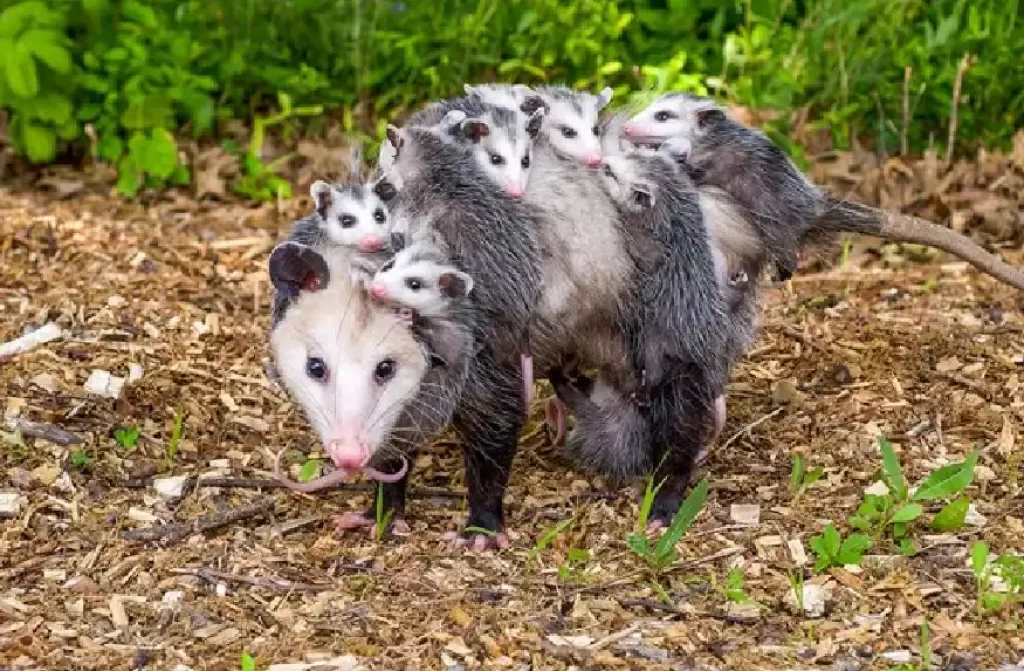
In recent years, the presence of Virginia opossums in urban areas has become an intriguing phenomenon. These adaptable creatures have demonstrated a remarkable ability to thrive in human-altered landscapes, making their way into the heart of cities and suburbs.
The Urban Opossum Phenomenon: Adapting to Human-Altered Landscapes
Despite being native to natural habitats, Virginia opossums have managed to establish themselves as urban residents, surprising both residents and researchers alike. Discover the reasons behind this urban expansion and how opossums have managed to adapt to city life.
Habitat Preferences: Seeking Shelter in the Concrete Jungle
Opossums exhibit remarkable flexibility in their habitat preferences, allowing them to thrive in urban settings. Explore the various types of urban habitats opossums inhabit and the specific features that make these environments attractive to them.
Food Sources: Opportunistic Foragers Amid Human Habitations
Opossums are resourceful eaters that can take advantage of the abundant food sources available in urban areas. Learn about the diverse array of food options opossums exploit, including human waste, gardens, and even pet food.
Navigating Urban Challenges: Opossums’ Strategies for Survival
Urban environments present unique challenges for opossums, from navigating busy roads to finding suitable shelter. Discover the strategies these resilient marsupials employ to overcome these obstacles and adapt to urban life.
Human-Opossum Interactions: Coexistence and Misconceptions
Understanding the benefits of having opossums in urban areas is crucial for promoting coexistence and dispelling misconceptions. Explore the positive roles opossums play in urban ecosystems, such as pest control, and address common concerns related to disease transmission, property damage, and noise.
Related animals
Appreciating the Virginia Opossum
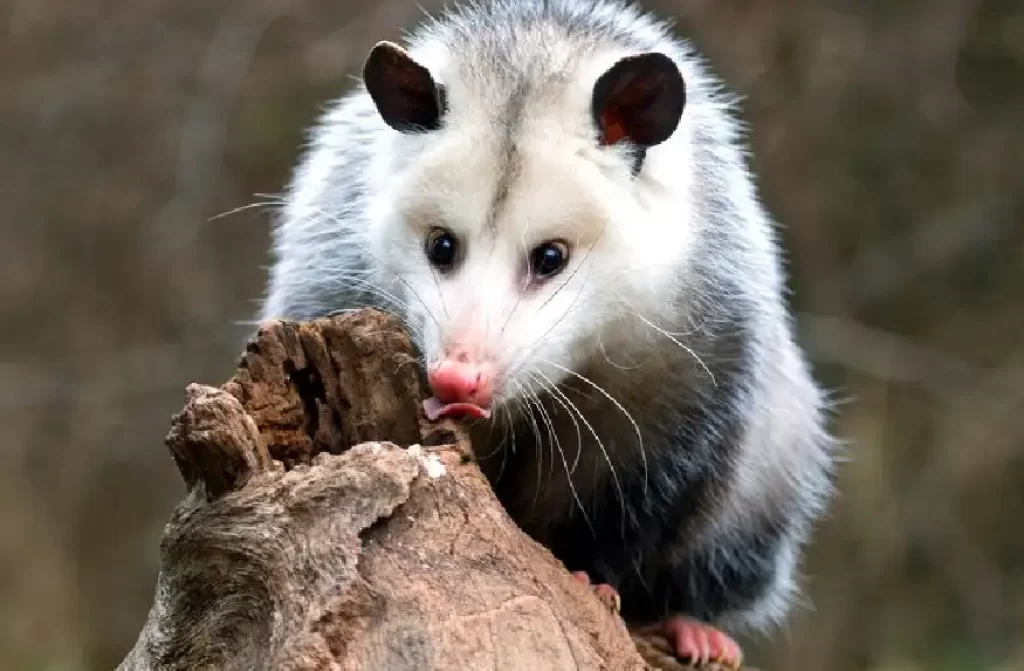
The Virginia opossum is a fascinating marsupial that holds a significant place in North American ecosystems. With their unique characteristics, including their nocturnal behavior, omnivorous diet, and adaptability to various habitats, they provide valuable insights into the wonders of the natural world.
Understanding and appreciating the Virginia opossum helps us recognize the delicate balance of life and the importance of conserving biodiversity. By protecting their habitats and promoting coexistence, we contribute to the preservation of our rich natural heritage. Let us cherish and safeguard these remarkable creatures and embrace our role as stewards of the Earth.
FAQ
Do Virginia opossums play a role in controlling pests?
Yes, Virginia opossums do play a role in controlling pests. As opportunistic omnivores, they have a diverse diet that includes insects, rodents, and other small animals, which are often considered pests. By feeding on these pests, Virginia opossums help naturally regulate their populations.
They are particularly effective at controlling ticks, as they groom themselves extensively and can consume large numbers of ticks, reducing the risk of tick-borne diseases.
Additionally, opossums are known to consume carrion, which helps clean up the environment and prevent the spread of diseases. Therefore, Virginia opossums contribute to pest control and help maintain ecological balance in their respective habitats.
Are Virginia opossums prone to diseases?
Yes, Virginia opossums can be prone to various diseases. Common diseases include sarcoptic mange, distemper, leptospirosis, toxoplasmosis, and rabies. However, opossums are generally not a significant threat to human health. It is important to maintain a safe distance from wild animals and seek assistance from wildlife authorities if you encounter a sick or injured opossum.
What is the conservation status of the Virginia opossum?
The conservation status of the Virginia opossum (Didelphis virginiana) is listed as “Least Concern” by the International Union for Conservation of Nature (IUCN). This means that the species is widespread and abundant, with stable populations throughout its range.
The Virginia opossum has adapted well to various habitats, including urban areas, and has a high reproductive capacity, which contributes to its conservation status. While individual populations may face localized threats, such as habitat loss or road mortality, the species as a whole is not currently considered at significant risk.
References:
- Virginia Opossum. (n.d.). In Wikipedia. Retrieved from https://en.wikipedia.org/wiki/Virginia_opossum
- The IUCN Red List of Threatened Species. (n.d.). Virginia Opossum (Didelphis virginiana). Retrieved from http://www.iucnredlist.org/details/40502/0



